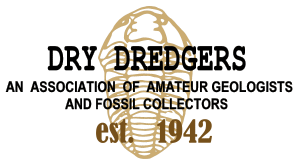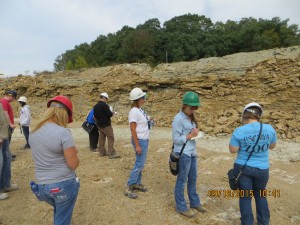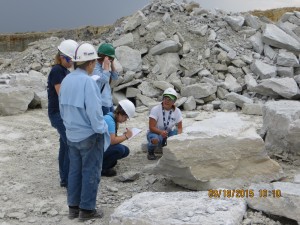In the fossil community, there has been much discussion about the connection between amateur and professional paleontologists, especially in light of new legislation that may restrict amateur collecting opportunities on government land. This blog post will not venture into the debate about that, but rather will focus on a recent example of collaboration between amateurs (Dry Dredger members) and professionals. This example, taken from an issue of the 2015 Dry Dredger bulletin, highlights the value to science of having amateurs in the field making paleontology discoveries and then sharing those with professionals and students.
Two Dry Dredgers Assist IUPUC Geology Class
Dry Dredger members Tom Bantel and Don Bissett recently assisted with a field trip for a geology class from IUPUC (Indiana University-Purdue University at Columbus).
Professor Marta Corbin teaches freshman geology at the university. A field trip location of interest is the New Point Stone quarry in Southeast Indiana. One Ordovician (Whitewater) and five Silurian (Brassfield, Osgood, Lewisburg, Massie, and Laural) formations are exposed there, permitting examination of stratigraphy, and collecting material for study and as teaching specimens. Since Tom and Don have collected this site for many years, and are familiar with some of the latest research done there by Drs. Carl Brett and James Thomka (University of Cincinnati), they were contacted by Professor Corbin to assist with the field trip.
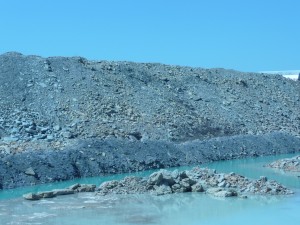
View of Ordovician (dark shale) in drainage ditch at bottom, with spoil pile of Silurian Massie Shale above.

View of all 5 Silurian formations in the quarry from the Brassfield Limestone at the bottom to the Laural Limestone at the top.
In addition to Professor Corbin, eleven students plus Mudge Morris (a retired professor who was Marta Corbin’s mentor) and Kevin Goode (a colleague of Marta) participated. Four different levels in the quarry were visited to examine all six exposed formations. In addition to helping the group differentiate the formations, Tom and Don lead them to specific areas for collecting both Ordovician and Silurian specimens (brachiopods, corals, gastropods, bryozoa, cephalopods, cystoids, etc.).
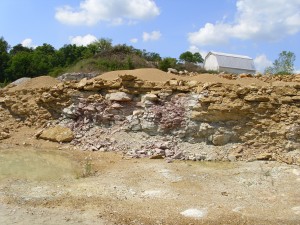
A popular stop in the quarry is a series of Ordovician sea stacks (the gray and purple rock) protruding into the golden Silurian Brassfield Limestone; the sea stacks are now gone having been blasted away as mining continues.
In 2014, these same two Dry Dredgers also assisted Professor Corbin with her geology class field trip to this quarry, and they plan to help if asked in the future.
Don Bissett

A long-time member of the Dry Dredgers, I’ve been collecting fossils ever since moving to Cincinnati in 1975 to work at P&G. I was introduced to fossil collecting by Bruce Gibson, another Dry Dredger and co-worker at P&G. Shortly after that, I met Dredger Dan Cooper. Both of them taught me a lot about the hobby. Ever since, I’ve been hooked on fossils.
My primary focus is collecting trilobites and echinoderms, though I often find myself accumulating a much wider assortment of fossils. Beyond the collecting hobby, I’ve also had the opportunity to work with professional paleontologists – extremely rewarding experiences. Some of those have been described in Dry Dredger Bulletin articles, MAPS (Mid-American Paleontology Society) articles, and technical publications. I plan to share more about collecting and professional interactions in my blog posts.Latest posts by Don Bissett (see all)
- Massie Shale Calymene - January 4, 2021
- Mississippian starfish - November 13, 2020
- Walcott-Rust Starfish - October 25, 2020
- Spathacalymene - September 20, 2020
- Penn Dixie Dig with the Experts 2018 - May 27, 2018

